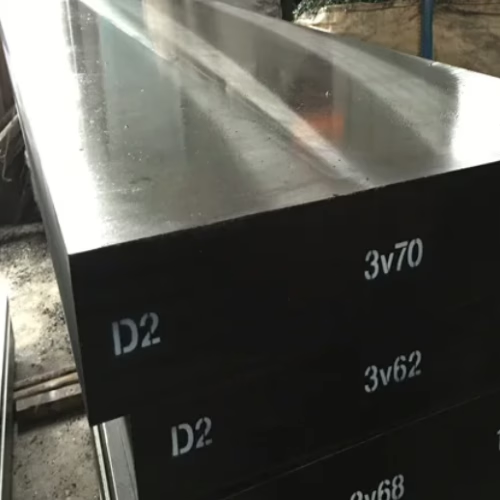Understanding D2 Steel Composition and Its Impact on Performance
1. What is D2 Tool Steel?
D2 tool steel is a go-to material in the cold work tooling industry. Its popularity is built on a specific blend of elements that give it some beneficial properties. If you’re thinking about using D2 for jobs like blanking, forming dies, or other tough tooling tasks, getting a handle on the D2 steel composition is key to knowing what it can do. At Aobo Steel, with our decades of experience in tool steels, we understand firsthand the importance of this chemical composition.

2. The Core Elements: D2 Steel Composition Breakdown
What makes D2 tick? It really comes down to its chemical ingredients. While you might see slight differences depending on the exact standard (like AISI or DIN 1.2379), the basic D2 steel composition doesn’t change much in its key alloying elements. Here’s what’s inside D2 and why it matters:
Carbon (C) – The Hardness Factor
Typical Range: 1.40% – 1.60% (e.g., 1.50%, 1.55%)
Role: D2 starts with a high carbon content. This carbon is vital for forming hard carbides, especially when it teams up with chromium. Think of these carbides as the main reason D2 resists wear so well.
Chromium (Cr) – Wear Resistance and Hardenability
Typical Range: 11.0% – 13.0% (e.g., 11.5%, 12.0%)
Role: There’s a lot of chromium in D2, and it’s super important. Chromium is a major player in forming lots of hard chromium-rich carbides (like M7C3). This is a big part of why D2 stands up so well to abrasive wear. Chromium also helps with hardenability, letting D2 get hard just by cooling in air after heat treatment (air hardening).
Molybdenum (Mo) – Adding Toughness and Hardenability
Typical Range: 0.70% – 1.20% (e.g., 0.80%, 0.90%)
Role: Molybdenum partners with chromium to improve hardenability, especially for air hardening. It also forms hard carbides and helps with secondary hardening during tempering – meaning it stays harder even when things get hot. Plus, Mo gives it a bit more toughness compared to simpler high-carbon steels.
Vanadium (V) – Even More Wear Resistance
Typical Range: 0.50% – 1.10% (e.g., 0.80%, 0.90%)
Role: Vanadium chips in by forming strong carbides too in the D2 steel composition. It creates incredibly hard vanadium carbides (MC type), which really push up the wear resistance, particularly against abrasion. Like Molybdenum, it also assists secondary hardening and helps keep the grain structure fine.
Other Elements
Manganese (Mn): Typically around 0.15% – 0.45%. Helps with hardenability and strength.
Silicon (Si): Usually 0.10% – 0.40%. Used during steelmaking and adds a little strength.
3. Key Properties You Get from D2 Steel Composition
This specific D2 steel composition results in the properties that make it such a solid pick for tough jobs:
High Wear Resistance: This is D2’s claim to fame, all thanks to the high amount of hard chromium and vanadium carbides from its high carbon, chromium, and vanadium levels.
Good Hardenability: The D2 steel composition, especially the chromium and molybdenum, means it can be air-hardened. It gets quite hard (typically 60-62 HRC, maybe more) with less warping than steels needing oil or water quenching.
Dimensional Stability: Because it air-hardens, there’s less stress and movement during heat treatment. That makes it reliable for tools needing tight tolerances.
Decent Toughness: It’s not the toughest steel out there, but the Molybdenum and Vanadium mean it holds up better than you’d think for a steel with this much carbon and chromium.
Machinability: Let’s be honest, its hardness and those abrasive carbides make D2 harder to machine than simpler steels. You need the right tools and approach.
Weldability: Generally tricky to weld because of the high carbon. It takes careful pre-heating and post-heating if welding is absolutely necessary.
In short, the unique mix in the D2 steel composition provides excellent wear resistance, high hardness, and good stability. That’s why it’s a workhorse for demanding cold work. Knowing about this composition helps you pick the right steel and get the most out of it with proper heat treatment.
If you have specific jobs in mind or need more info on how the D2 steel composition affects performance in certain situations, ask us at Aobo Steel.
For a complete reference, download the D2 steel composition PDF.
Explore Our Other Products
D2/1.2379/SKD11
D3/1.2080/SKD1
D6/1.2436/SKD2
A2/1.23663/SKD12
O1/1.2510/SKS3
O2/1.2842
S1/1.2550
S7/1.2355
DC53
H13/1.2344/SKD61
H11/1.2343/SKD6
H21/1.2581/SKD7
L6/1.2714/SKT4
M2/1.3343/SKH51
M35/1.3243/SKH55
M42/1.3247/SKH59
P20/1.2311
P20+Ni/1.2738
420/1.2083/2Cr13
422 stainless steel
52100 bearing steel
440C stainless steel
4140/42CrMo4/SCM440
4340/34CrNiMo6/1.6582
4130
5140/42Cr4/SCR440
SCM415
✅ Special Offer for D2 Tool Steel Buyers
Get a Free Cutting Service or Hardness Test Report with Your First Inquiry!
✔ Direct-from-factory price — no middleman
✔ Mill Test Certificate (MTC) included
✔ Over 20 years of forging experience
✔ Ready stock in standard sizes: Flat / Round / Block
💡 Bonus: Ask now and get our “D2 steel composition” (PDF) — Free for serious buyers.
📩 Send your size & quantity now. We respond within 6 hours.
